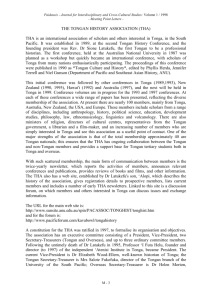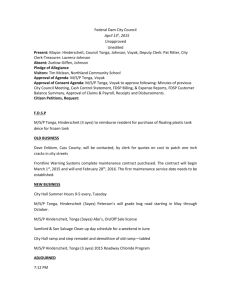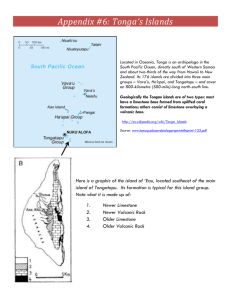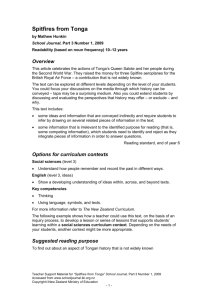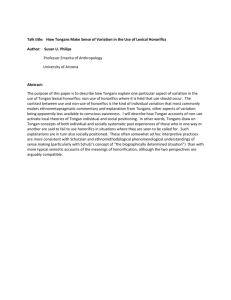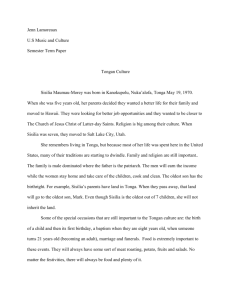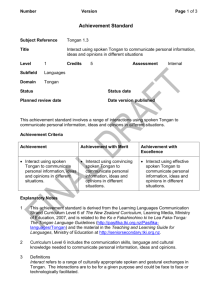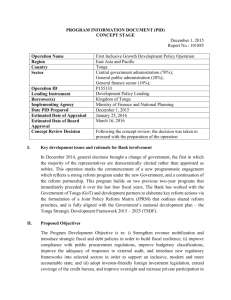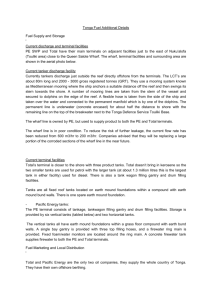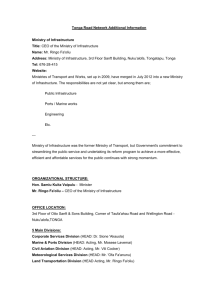The Economy of Constructing and Maintaining
advertisement
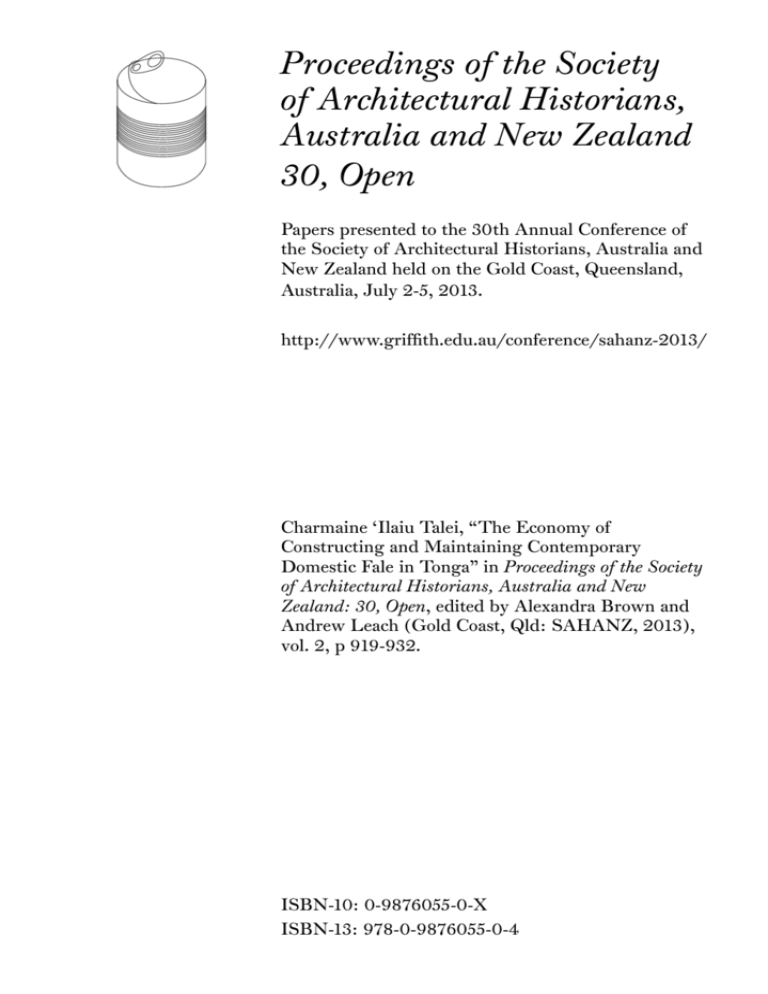
Proceedings of the Society of Architectural Historians, Australia and New Zealand 30, Open Papers presented to the 30th Annual Conference of the Society of Architectural Historians, Australia and New Zealand held on the Gold Coast, Queensland, Australia, July 2-5, 2013. http://www.griffith.edu.au/conference/sahanz-2013/ Charmaine ‘Ilaiu Talei, “The Economy of Constructing and Maintaining Contemporary Domestic Fale in Tonga” in Proceedings of the Society of Architectural Historians, Australia and New Zealand: 30, Open, edited by Alexandra Brown and Andrew Leach (Gold Coast, Qld: SAHANZ, 2013), vol. 2, p 919-932. ISBN-10: 0-9876055-0-X ISBN-13: 978-0-9876055-0-4 The Economy of Constructing and Maintaining Contemporary Domestic Fale in Tonga Charmaine ‘Ilaiu Talei University of Queensland How does economic anthropology extend our understanding of the architectural production—construction and maintenance— of contemporary domestic fale in Tonga? Through participant research, fieldwork observation and visual anthropology recent, fieldwork findings highlight a range of economic activities that enable the construction and maintenance of Tonga’s contemporary domestic fale, or house. Four economic activities are described: remittance, toli, or seasonal work overseas, fale koloa, or shop, and koloa manufacture—Tongan textiles— and their architectural implications on the fabric and form of fale. The paper begins with a discussion of Tonga’s economic history and explains how earlier forms of economy blend with new capitalist systems, creating what this paper proposes as a contemporary hybrid Tongan economy. Aspects of hybrid economic theory, such as the work of Mayfair Mei-hui Yang (2000) and Jon Altman (2009) assist the evaluation of Tonga’s hybrid economy. Furthermore, current findings highlight that as the aforementioned economic activities are performed and applied to Tongan fale it does not create a clearly hybrid form or even fabric, but rather a hybrid architectural production with various local and global sources and modes. Economic anthropology is a diverse framework beginning with the work of Malinowski (1922) and Firth (1929) in the Pacific. The paper significantly fuses some of their economic anthropological concepts and architectural history to build an understanding of the construction and maintenance of Tongan fale. Reciprocally, the architectural illustrations contribute to emergent discussions within economic anthropology about the evolution of economies in post-contact societies. ‘ILAIU TALEI 919 Economic changes have critically altered the fabric and form of Tongan contemporary domestic fale,1 or houses. In the 1930s2 Tonga experienced a significant shift from plant fibre building technologies to imported building materials. The predominant reason for this material and architectural change was the occurrence of increased international economic activities occurring in Tonga at that time, which involved greater access to foreign currency and commodities. Within this historical context this paper asks how does economic anthropology extend our understanding of the architectural production—construction and maintenance—of contemporary domestic fale in Tonga. First the paper situates Tonga’s current economy within economic anthropological theory. Then discusses the production of contemporary fale in light of current Tongan economic activities gathered in recent fieldwork, before reflecting on this paper’s opening question. The significant research contribution of this paper is how it fuses economic anthropological methods and architectural historical methods to better understand the changes of fabric and form in contemporary Tongan fale. 1. The usage of fale in this paper perpetuates the argument set by the author in earlier SAHANZ paper, which purports fale is a concept applied to a Western-looking domestic building in Tonga. Not a demarcation between traditional or non-traditional, rather forever evolving and therefore considered in this paper as an early, late or contemporary evolution of a fale Tonga.—Charmaine ‘Ilaiu, “‘Inasi: Tonga’s Reason for Its Western Fale” in Cultural Crossroads: Proceedings of the 26th International SAHANZ Conference, ed. Julia Gatley (Auckland: SAHANZ, 2009), cd-rom, 8-12. 2. Ian C. Campbell, Island Kingdom: Tonga Ancient & Modern (Christchurch: Canterbury University Press, 1992), 152. Economic History Economic anthropology is a diverse framework that finds its beginnings in the work of anthropologist Bronisław Malinowski3 and Raymond Firth4 in the Pacific; then later theorised by Mauss, Polanyi and Sahlins.5 Some historical aspects of this discourse are generally relevant to Tongan society such as ceremonial exchanges and more specifically to Tongan architecture: food production, external trade, gifting and reciprocity. For a long time these “non-instituted” processes have defined economic anthropology. However new forms of economy have also emerged in these post-colonial cultures paradoxically involving money,6 as this paper exemplifies. In particular the interactions between the global and local Tongan raise discussions regarding remittance and seasonal work migration schemes. Contemporary strands of Tongan economy are not entirely new, such as external trade: pottery and tools were traded amongst Fijians, Samoans and Tongans during the maritime chiefdom of Tonga, which developed in the fourteenth and fifteenth centuries AD.7 These trade relationships paved the way for new organic building material ideas and technologies, once exchanged amongst these island groups. From the mid twentieth century external trade consisted of agricultural exports, such as banana exports to New Zealand during the 1970 to 1980s and more recently squash to Japan. 920 ‘ILAIU TALEI 3. Bronislaw Malinowski and Robert Mond, Expedition to New Guinea. Argonauts of the Western Pacific: An Account of Native Enterprise and Adventure in the Archipelagoes of Melanesian New Guinea (London: Routledge and Kegan, 1922). 4. R. Firth, Primitive Economics of the New Zealand Maori (London: George Routledge, 1929). 5. Chris Gregory, “Whatever Happened to Economic Anthropology?” Australian Journal of Anthropology 20, no. 3 (2009): 285-300, esp. 285. See also Marcel Mauss, The Gift: Forms and Functions of Exchange in Archaic Societies (London: Cohen & West, 1969); Karl Polanyi, Harry W. Pearson and Conrad Maynadier Arensberg, Trade and Market in the Early Empires: Economies in History and Theory (Glencoe, Ill.: Free Press, 1957); Marshall David Sahlins, Stone Age Economics (London: Tavistock Publications, 1974). 6. Gregory, “Whatever Happened to Economic Anthropology?” 296-97. 7. Clark, Geoffrey et al. “Monumentality and the Development of the Tongan Maritime Chiefdom.” Antiquity, no. 82 (2008): 994 – 1008, esp. 994. 8. Ferdon Edwin, N. Early Tonga: As the Explorers Saw It 1616 - 1810. (Tucson: University of Arizona Press, 1987) 8. 9. Symbolic capital after Pierre Bourdieu, “The Forms of Capital” in Handbook of Theory and Research for the Sociology of Education, ed. J. G. Richardson (New York: Greenwood Press, 1986). Traits of early ceremonial exchanges are also evident today through reciprocity. The ‘inasi ceremony was an important early ritual exchange observed by several colonial European explorers, including Captain Cook in 1773.8 Tongans would bring their ‘inasi: root crop offerings and textile gifts, to display before the paramount chief Tui Tonga. The chief would assess their ‘inasi and clearly understand the quality of his natural resources and the diligence of his people and quickly appraise their sustainability. For commoners, the ‘inasi ceremony was a time to display one’s ability, creativity, diligence and be esteemed amongst their peers and honourable chiefs of the event. Thus in offering ‘inasi, one would gain non-tangible benefits (symbolic capital9), which in time could lead to material benefits in various forms such as being given more land from a chief who witnessed one’s diligence, or a commission to weave mats directly for nobility. Traits of this ‘inasi ceremony have continued in the way people perform economic activities that construct and maintain houses through reciprocity and gifting, albeit now commonly performed between members of a family or community. Reciprocal transactions of supplying goods and services are done in goodwill with an expectation the exchange will be completed in the future with no specific date set between parties. As one initiates the service or presentation of goods, the receiver will remember the economic activity and reciprocate. Not necessarily in the same way or with the same thing. Building services and materials are the evolving elements in these new economic exchanges. Reciprocity and gifting is witnessed in how Tongans offer building materials or labour to their neighbour with the desire to help; but intuitively a transaction of reciprocity has started. Economic activities involving foreign currency and commodities began in the early nineteenth century when permanent Western settlers, such as missionaries and traders had something to sell to the local Tongan community. In particular, early foreign trade and church donations increased the distribution of money and commodities in Tonga. The first known foreign trade of coconut oil was by a “resident foreign trader” who arrived in 1844. The success of this trade motivated more to arrive on Tonga’s shores bringing with them money or goods to exchange with Tongan locals.10 From the late 1800s, participating in Church donations, 10. Campbell, Island Kingdom, 103. 11. Misinale is a Tongan translation of the Methodist church term: “mission(s).” Donating to a church mission continues to be practiced today ranging from education, new church equipment or evangelistic event. 12. Campbell, Island Kingdom, 96. although less extravagant than the early ‘inasi ceremony, was nonetheless also a public display of ability and monetary wealth. At these misinale11 events, Tongans could gain honour not just from God but also from the watching congregation who witnessed their generous offering.12 From the mid-twentieth century Tongans became more literate; education was key to securing employment in developing government and commercial sectors. Tongans began moving overseas to work under seasonal ‘ILAIU TALEI 921 employment schemes with the New Zealand Government or sent to Australia under Methodist Church scholarships. This Tongan diaspora soon sent money and materials back to family members living in the village. These remittances provided Tongan families with a means to build new domestic fale in the village and houses took on new forms and fabrics. Considered progressive13 by many families, this new domestic stock was apparently “local” since the buildings were interpretations by local builders using imported materials. Changes in form and fabric were certainly more visible with emigration and the flow of money and building materials through remittances. 13. Fakalakalaka is the locally constructed concept often discussed by participants, which defines what is progressive. Currently investigated by the author. Tonga’s Contemporary Hybrid Economy Tongan economy did not change entirely from an informal economic system to a capitalised one. Instead a hybridisation process has occurred where some of the earlier forms of economy persist but in new contexts or through or alongside new capitalised processes. I am not alone in this economic conclusion; cultural anthropologist Jane Horan also observed the persistence of local hybrid economies as they merged with microcredit schemes in Tonga.14 My fieldwork, conducted during 2012 and 2013, indicates a blend of economic systems that influence the construction and maintenance of Tongan contemporary domestic buildings. Some (but not all) of the types of economic activities include remittance, toli, or seasonal work overseas, fale koloa, or shop enterprises, and koloa making, or the making of texitle goods usually as a member of a women’s collective.15 The blend of economic activities that construct and maintain houses in Tonga therefore lends itself to hybrid economic models, a method of economic anthropology. I draw upon the models of Mayfair Mei-hui Yang16 and Jon Altman.17 They discuss the need to theoretically “move away from a monolithic global capitalism” and notions of “one way penetrations of capitalism” of indigenous communities.18 Like Yang’s study of Wenzhou in China, the value of money in Tonga is transformed in ritual economies. Similar to Altman’s Aboriginal examples, the situation in Tonga shows an overlapping of capitalist operations with customary forms of economic transactions. However the different cultural contexts also mean Tonga presents different components of the hybrid model than as discussed in Yang and Altman’s hybrid economies (fig. 1). In this next section I describe the aforementioned four economic activities employed by Tongans to construct and maintain their houses and explain the ready ease of blending economic activities to produce contemporary fale. 922 ‘ILAIU TALEI 14. Jane C. Horan, “Indigenous Wealth and Development: Micro-Credit Schemes in Tonga,” Asia Pacific Viewpoint 43, no. 2 (2002): 205-21, esp. 219. 15. Puaka, or the nurturing and selling of pigs, bank loans, foreign aid and local employment are not discussed in this paper due to word limit restraints. 16. Mayfair Mei-hui Yang, “Putting Global Capitalism in Its Place,” Current Anthropology 41, no. 4 (2000): 477-509. 17. Jon Altman, “The Hybrid Economy and Anthropological Engagements with Policy Discourse: A Brief Reflection,” Australian Journal of Anthropology 20, no. 3 (2009): 318-29. 18. Yang, “Putting Global Capitalism in Its Place,” 477. Figure 1: Tonga’s hybrid economy made up of 1: customary activities, 2: subsistence activities, 3: market activities, 4. bureaucratic activies. The economic activities: remittance; seasonal work migration; fale koloa and koloa making straddle across these divisions quite easily, ‘Ilaiu Talei. Construction and Maintenance 19. Howard Davis, The Culture of Building (New York: Oxford University Press, 1999), 11. 20. Remittance is the flow of money, primarily, and often goods, between internal and international migrants to families in home islands. 21. Tongan Government’s Ministry of Infrastructure, Transport and Works have started to enforce building permits for medium to large-scale projects. A building application and architectural drawings now must be lodged at the Ministry of Works, Tongan Government. Two architectural terms “construction” and “maintenance” are specific to the production of contemporary Tongan domestic architecture, which requires definition. Construction in the Tongan context is best defined by architectural writer Howard Davis19 who explains that “[r]ather than individual phenomena that result from independent acts of creation, buildings are products of social processes that vary in systematic ways from place to place and over time.” Certainly, construction is a social system in Tonga that begins with an initial discussion of the project between owner and builder. Next one spends an extensive amount of time sourcing the capital and labour amongst one’s community. In conjunction, the owner will begin to source and specify building materials, usually from the industrial central island Tongatapu or overseas through the remittance20 of building materials from kinspersons. These materials are delivered to the project site and organised by the owner in consultation with the builder. The build and design process is then carried out by a builder and general labourers. In essence construction in Tonga is owner-driven and based on one’s ability to source funds, gather materials, impress ideas and aspirations on supporting relatives and labourers. Architectural design often is about this assemblage of building materials and labour before a full design concept emerges in peoples’ minds and sometimes on paper. Until recent times no architectural professionals were involved21 and builders addressed design and ‘ILAIU TALEI 923 structural questions as the project proceeded. Maintenance also has a broader definition including the general cleaning, repair, and refurbishment; but in particular the extensions to an original house due to new needs of the family. Remittance and Seasonal Work Migration Remittance22 and seasonal work migration, known as toli by locals, are discussed together because they are integral to the diasporic and transnational23 Tongan finding work overseas, then blended with customary gift giving or reciprocity back to respective communities in Tonga. Several researchers have discussed how private remittances were critical cash sources for Tongan-based families.24 These remittances are transferred electronically through agents like Western Union, Moneygram, or one of the several Tongan companies like Melie mei langi. The Tongan-owned money transfer enterprise highlights a growing local demand and the profitable trade of currencies. Before this modern infrastructure, it was common to send back money through mailed letters or a fakamoemoe—a parcel—to a trusted person travelling to Tonga. A type of remittance, known as “architectural remittance” was also observed during my masters research during 2007-200825 and continues 22. Literature about gift giving exceeds this paper, however note 24 presents discussions regarding Tonga’s situation. 23. This paper distinguishes between diasporic and transnational. Diasporic means a group belonging to another place and foreign in new host country. Transnational means individuals, who are not particular to one place or live in between countries. Refer to Thomas Hylland Eriksen, Globalization: The Key Concepts (Oxford: Berg, 2007), 113. 24. Geoff Bertram, “The Mirab Model Twelve Years On,” Contemporary Pacific 11, no. 1 (1999), 105, 119; also Geoff Bertram and Ray Watters, “New Zealand and Its Small Island Neighbours: A Review of New Zealand Policy toward the Cook Islands, Niue, Tokelau, Kiribati and Tuvalu,” Institute of Policy Studies Working Paper 84/01 (1984), 379; Helen Morton Lee, Tongans Overseas: Between Two Shores (Honolulu: University of Hawaii Press, 2003), 32,33. 25. “Architectural remittance” is coined by the author in ‘Ilaiu, “‘Inasi,” 8-12. as a reliable contribution to construction. I presented six contemporary domestic fale and two in particular—fale ‘Amelika and fale Tufitufi— showing how building materials were sent from Pacific Rim cities to relatives in the villages. One’s ability, therefore, to build relationships with family living overseas through reciprocity has a greater chance of building their home through the economic activity of remittance. In a recent address at the Pacific Update Forum hosted by Australian National University, the Governor of Tonga’s Reserve Bank Hon. Siosi C. Mafi explained that since the 2007 to 2008 global financial crisis private remittances from the Tongan diaspora have declined. For this reason she stressed that remittance is not a sustainable form of investment for Tonga and the government needs to consider alternatives to generate local income and consumption.26 In addition to the global financial crises, the reduction in remittance can be attributed to the changing attitudes towards it, particularly amongst the children of first Islander migrants. Anthropologist Helen Lee has found that there is less of a connection and obligation to the motherland unlike their parents’ generation who were more motivated to send remittance.27 Clearly, the 924 ‘ILAIU TALEI 26. Siosi C. Mafi, pers. comm., “2012 Pacific Update: Papua New Guinea, Timor-Leste, Fiji, Vanuatu, Solomon Islnds, Samoa and Tonga,” Australian National University Development Policy Centre, Canberra, September 6, 2012. 27. Helen Lee, “Generational Change: The Children of Tongan Migrants and their Ties to the Homeland” in Tonga and the Tongans:Heritage and Identity, ed. Elizabeth Wood Ellem (Alphington, Vic.: E. Wood-Ellem for Tonga Research Association, 2007), 211. reduction of remittances (cash and materials) could potentially reduce the number of new domestic buildings built in Tonga in the immediate and long term. Toli, or seasonal work migration, is an economic opportunity for Tongans who want to pursue employment overseas but are unable to gain a work permit due to limited skills and education. In the Pacific Rim, New Zealand and Australian Governments administer some seasonal work programmes. Australia’s Pacific Seasonal Worker Pilot Scheme aims 28. Australian Government. “Department of Immigration and Citizenship,” online at http www. immi.gov.au/skilled/seasonal-worker (accessed September 4, 2012). 29. Manase Tuimoala, pers. comm., “Exploring how coconut is used to make the fale Tonga,” Fangale’ounga village, Foa Is., Ha’apai group, Tongan Islands, May 21, 2012; Similone ‘Ilaiu, pers. comm., seasonal migrant worker once based in Emerald, Queensland, rural Victoria and Darwin, Northern Territory, July-December 2012. to improve cultural awareness between employers and Pacific Islander workers; engage local residents to provide community support and involvement for Pacific Islander workers; and provide shared opportunities for cultural activities.28 However, Tongan people I have engaged who undergo these opportunities state that making large amounts of money to achieve their big goals, such as building a house in the village, is their primary objective.29 Seasonal work overseas and remittance are partly dependent upon government decisions regarding immigration and driven by market needs, such as Australia’s labour shortage in rural areas or work opportunities overseas. In Australia seasonal work programmes are mostly organised by independent Tongan agents working directly with an Australian farmer. These middlemen provide free or affordable accommodation for its workers. So although it can be a brief period of work, usually up to six months, a worker could save a considerable amount of money to send or return with to families in Tonga. Architectural remittance of building materials is a more difficult task because a worker is restricted by remote working conditions. Time and access to large hardware stores are imperative to source and organise building materials to be shipped back to Tonga. However, toli appears to be the emergent economic activity that complements remittance when Tongans build their fale, especially as the numbers of remittances are predicted to decrease. Architectural Implications In February to March 2013, a survey was conducted with 29 house owners in the village Tatakamōtonga. Fourteen were built primarily by remittances and an extra two built partially by remittance and another economic activity. These sixteen houses were built at different times from the late 1960s to the present day. The majority of these houses (nine) are built from concrete block walls and on concrete slab with timber roof framing and corrugated metal roofing. These concrete houses are considered more progressive and thus recent constructions. The other ‘ILAIU TALEI 925 Figure 2: A house constructed by toli wages and completed with reciprocity and gifted labour by family members. Aliki house, Tatakam tonga village, Tongatapu Island, ‘Ilaiu Talei, February 2013. seven houses are built from a variety of timber framed combinations, the most common type has weatherboard cladding, corrugated metal roof and on concrete piles. Similarly another type with fibre cement sheet cladding, corrugated metal roof on concrete slab. Interestingly the houses built by toli were all constructed in the concrete block type. An outstanding example, is built by Tevita Fetongi Aliki30 a thirty-year-old man who recently returned from working in Emerald, Queensland for seven months (fig. 2). Tevita explains TOP$30,000 from his toli wages was used to purchase local materials to build his family’s house. Apart from money, gifted labour was offered from Tevita, his brother and cousin—an experienced builder—for the construction of this concrete block house. Aliki’s house is a rare example; most toli houses are built with a blend of remittance activity showing the persistence of remittance-built fale in Tonga. For example in December 2012 a concrete blockhouse began construction, owned by Kelela Finau31 and her family. At the time of my interview, Kelela’s youngest son had recently returned from seasonal work in Australia with TOP$15,000 for the house’s roof. The house was co-funded by all her sons, with another two living in Hawaii who regularly sent back remittance to fund different parts of the build. The local builder and his labourers were paid a discounted fee (a gift from builder to clients) and fed two free meals per construction day in the act of reciprocity by Kelela and her husband. Thus highlighting a close connection between toli and remittance, similarly how easily other customary forms of economy are blended to produce a fale in Tonga. The houses built by remittance were primarily constructed with money sent over by relatives, not overseas building materials. This is due to the cheap and local concrete block that is most preferred today as a building 926 ‘ILAIU TALEI 30. Tevita Fetongi Aliki, pers. comm., “Housing histories and aspirations in two Tongan villages,” Tatakamōtonga village, Tongatapu Is., Tongan Islands, February 17, 2013. 31. Kelela Finau, pers. comm., “Housing histories and aspirations in two Tongan villages,” Tatakamōtonga village, Tongatapu Is., Tongan Islands, March 1, 2013. material over timber construction. When this fabric is purchased locally, sometimes cement bags and reinforcement wire is sent over from overseas by relatives to complement the build. Other architectural remittance materials sent from overseas may include: corrugated metal roofing, timber and especially door and window joinery and internal fixtures. The survey stressed that remittance and toli-constructed houses do not always take on an overseas style, as may be assumed. Rather locals are happy to select a style that is determined by their village or family builder. This builder may discuss his ideas with his clients, or the clients may leave the design layout and style all in the hands of the builder. On rare occasions the overseas relatives who are funding the project, in the case of remittance, may provide a brief to be incorporated by the builder, like the number of bedrooms and whether the kitchen or bathroom is internalised. Therefore in terms of form, the fale is constructed by a local interpretation of what is most progressive; what suits the budget of the client and what meets the requirements of the family. Most often this results in a simple rectangular hipped or gable house with a living room, small hallway and two to four bedrooms. Bathroom and kitchen facilities are included at a later date or in an ancillary building beside the main house. This typical staging approach tends to mirror the instalments of monetary gifts and remittances from overseas employment. 32. Tuimoala, pers. comm. Manase Tuimoala32 holds a respected position as a policeman in his community, however he views toli as an opportunity to make more money in a shorter amount of time to pay off his mortgage to the bank. Many other young to middle age Tongan men seek out this opportunity and are determined to build their first house or maintain their current homes on their return. Certainly today, toli and remittances are effective economic activities that can build and maintain contemporary domestic fale in Tonga. 33. In Tongan custom, mats are part of an elaborate hierarchy of koloa—or customary wealth—that a Tongan woman collects to fulfil her customary duty within her respective community. Koloa making is part of a wider discussion of gifts of exchange studied by anthropologists: Adrienne L. Kaeppler, “Kie Hingoa: Mats of Power, Rank, Prestige and History,” Journal of the Polynesian Society 108, no. 2 (1999): 168-232; Phyllis S. Herda, “The Changing Texture of Textiles in Tonga,” Journal of the Polynesian Society 108, no. 2 (1999): 149-67; Ping Ann Addo and Niko Besnier, “When Gifts Become Commodities: Pawnshops, Valuables, and Shame in Tonga and the Tongan Diaspora,” Journal of the Royal Anthropological Institute 14, no. 1 (2008): 39-59; Fanny Wonu Veys, “Materialising the King: The Royal Funeral of King Taufa’ahau Tupou Iv of Tonga,” Australian Journal of Anthropology 20, no. 1 (2009), 131. Fale koloa and Koloa Making Fale koloa, or shop and the making of koloa—valuable textiles such as tapa cloth or woven goods—are local enterprises, where village entrepreneurs use ingenuity to create livelihoods from making and selling goods and to an extent providing a service. Koloa making operates usually in a collective consisting of three or more women. This economic activity brings together subsistence, market activities and remittances and is motivated by textile exchanges.33 The fale koloa blends remittance-associated activities but with an emphasis on a market type economy. ‘ILAIU TALEI 927 From the mid-twentieth century the fale koloa was once a small Tongan operated store positioned at the front of the main house in a village. By selling agricultural crops, qualifying for a bank loan34 or receiving monetary assistance from an overseas relative a family could start a shop. For most families this happened when a relative moved overseas and sent back money to build a shop or buy goods from a large supermarket in town, like Morris and Hedstrom, to resell the commodities in their remote villages at a slightly higher price. Sometimes shop goods were sent from New Zealand, especially lamb flaps. 34. Niko Besnier, “Modernity, Cosmopolitanism, and the Emergence of Middle Classes in Tonga,” Contemporary Pacific 21, no. 2 (2009): 215-411, esp. 226. For some families, the fale koloa was the only means to generate cash, especially if no one else was working or living overseas. A survey of Tatakamotonga village, during fieldwork in June 2012, shows that on every street there is at least one fale koloa (fig. 3). Sometimes almost every house on that street has a fale koloa—which is a lot of competition! However, today most, if not all, of these fale koloa are not operational. It is common to see such old fale koloa, reused as a storage space or extra bedroom for young male members of the family. Cultural anthropologist Niko Besnier explains Tongan shops “succumbed to Figure 3: One part of my mapping studies of Tatakam tonga village surveying the occupancy per allotment, green: allotment and house lived in permanently, red: allotment/and house abandoned, blue: allotment and house lived in temporarily by the owner, black with an ‘s’: a shop. Tongatapu Island, June 2012, ‘Ilaiu Talei. 928 ‘ILAIU TALEI 35. Besnier, “Modernity, Cosmopolitanism, and the Emergence of Middle Classes in Tonga,” 227. obligations of kinship relations” leading to their closure. In addition many fale koloa could not compete with the Chinese retailers who began to set up shops from the 1990s.35 Entrepreneurial Tongans have also found a way to receive cash if not selling directly. Now several rent out their stores to Asian shopkeepers, who would live behind their shops in the back room or in a lean-to added to the store with its own bathroom facilities. The business of koloa making comprises of several textile work in Tonga. On the main island especially, this includes kau tou langāngā, the collectives who specialise in tapa cloth. In remote islands there are more kau tou lālanga, which are collectives specialising in weaving fine mats. Each collective are organised in a way where koloa are sold to customers who require these textiles for ritual exchanges. The most preferred customer being the overseas Tongan woman. In one transaction, an overseas customer can request a specific order, which the collectives follow. Once the tapa cloth or mat is complete, it is sent to the customer overseas who then sends money back to the collective through a money exchange medium, like Western Union. Money is then dispersed as wages amongst the collective. Another type of transaction is a katoanga, or gathering, which is set with a date and venue by the collective and customers. Everyone meets at this appointed katoanga and exchange mats for cash or goods. In this situation, the members of the collective could ask their overseas customer to provide a shipping box full of household white ware and furniture sourced from overseas rather than cash. Architectural Implications 36. Fine Tuimoala, pers. comm., “Exploring how coconut is used to make the fale Tonga,” Pukotala village, Ha’ano Is., Ha’apai group, Tongan Islands, May 19, 2012; Tuimoala, pers. comm., May 22, 2012; Kisaia Vaoahi, pers. comm., “Exploring how coconut is used to make the fale Tonga,” Hihifo village, Niuatoputapu Is., Tongan Islands, May 26, 2012. In analysing the relationship of fale koloa and koloa making, both apply a market system based on selling a valuable good. In addition, they have maintained a house moreso than build one. According to several participants,36 kau tou lālanga provides a means for women to maintain their homes, particularly in terms of decorating and furnishing. However, in the case of the fale koloa it is reasonable to suggest that it has the potential to build a house and not just maintain, if its market is extended beyond a small-scale business. Perhaps, the partnership with Asian retailers could provide the sizable profits needed to build a house. So much so, the fale koloa could guarantee a bank loan to construct a house. Architecturally the fale koloa stands as an extension of the house’s threshold as a social place to meet village community while serving customers or yarn with people who wait under the shop’s awning for the ‘ILAIU TALEI 929 Figure 4: A fale koloa, now operated by Chinese, stands out the front of a timber framed house, Sepesi house, Tatakam tonga village, Tongatapu Island, ‘Ilaiu Talei, February 2013. Figure 5: Interior of the shop front space with makeshift sleeping quarters around the corner and behind this partitioning wall an actual bedroom, Vake House, Tatakam tonga village, Tongatapu Island, ‘Ilaiu Talei, May 2012. bus (fig. 4). The fale koloa is a small structure on average between six to ten square metres, usually made from a light frame with corrugated metal or timber cladding. Often the fale koloa is built at the same time with the main house. For this reason, the fale koloa as an economic activity is not involved in constructing the original house, but usually maintains the main house and funds the next stages of the project. Like the owners of a newly built house in Tatakamotonga (fig. 5), they chose to build a fale koloa with one bedroom, kitchen and bathroom facilities in the first stage of construction. The shop’s profit pays the utility bills of the house, as they await more remittance to fund the next stage of the project. The koloa enterprise is also carried out on home property, sometimes in a specially made organic fale or ancillary building for women’s work. Alternatively, the living rooms provide sufficient space for some of the koloa work. Therefore, koloa activity has less of an impact on the form of the main house than the fale koloa, because collectives can make do with any dry ventilated space indoors or outdoors. Again, the main house’s choice of fabric is not affected directly by both economic activities, since these business structures are easily made from leftovers of the main build. 930 ‘ILAIU TALEI Figure 6: Sketch of the layout of fale koloa, weaving shed and main fale owned by Sione Fakav Tuimoala in Pukotala village, Ha’ano Island, Ha’apai group, Tongan Islands, ‘Ilaiu Talei, May 2012. The most critical decision, affecting fale organisation, is where to place these business structures in relation to the main house. It is sometimes placed with consideration of the women’s role and daily activities, because they often maintain the family store. A timber framed house owned by Sione Fakavā Tuimoala in Pukotala village, in the remote island of Ha’ano displays this interesting scenario (fig. 6). The fale koloa was located beside the main house with a metre pathway linking a door from the living room and the entry door into the store. A few metres away behind the store stood another corrugated metal clad timber structure, which housed the weaving collective’s work. I personally observed the female attendant of the shop, run between her family store and weaving when customers arrived. Certainly fale koloa and koloa manufacture are economic activities affecting the organisation of fale in one’s home. Summary This paper shows how economic anthropology is a relevant framework that extends our understanding of the architectural production of contemporary Tongan fale. A discussion of these four economic activities—remittance, toli, fale koloa and koloa making—highlights how easily capitalist and more customary forms of Tongan economy are blended creating complex economic systems that influence the form and fabric of houses. These overlaps show the difficulty and variance of building realisation and maintenance in Tonga’s domestic architecture. It is clear that remittances and toli are the “best” ways to currently access large amounts of money quickly to build a house in Tonga. Conversely, there is a clear disadvantage for those who do not have this privilege and thus a housing disadvantage as well. For these people, attaining education and securing local employment and bank loans appear to be the alternatives, which are challenging options in themselves. ‘ILAIU TALEI 931 Fale koloa and koloa manufacture are locally based economic activities that are useful means of maintaining a home. The scalability of these activities could allow more financial opportunities that could fund a house construction. This paper’s opening question was how can economic anthropology extend our understanding of architectural production—construction and maintenance—of the contemporary domestic fale in Tonga? The paper has attempted to answer this question by highlighting the evolution of Tongan economy from customary processes to more capitalised systems; an economy not in either extremes, but rather a hybrid form. As economic activities like remittance, toli, fale koloa and koloa making are performed and applied to Tongan fale it does not create a clearly hybrid form or even fabric, but rather a hybrid production from various local and global sources and modes. At the core of economic anthropology is value. A methodological significance of this paper is the fusion of economic anthropological concept of value and architectural historical production of value. This method has tracked the distribution and sources of architectural value stored in the Tongan fale’s architectural form and fabric and the hybrid economic processes Tongans undertake to achieve this architectural value. 932 ‘ILAIU TALEI
